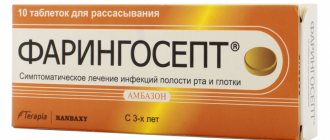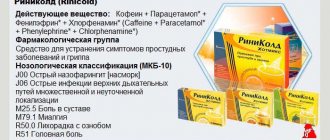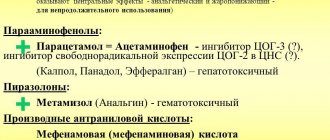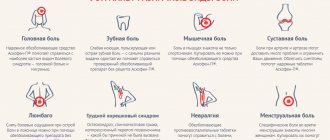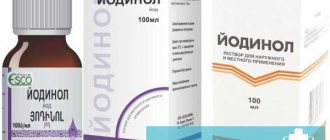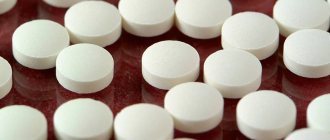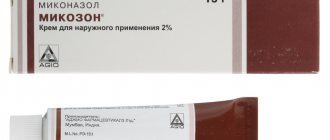Analgin is one of the most effective painkillers. The drug belongs to non-narcotic analgesics, medications that reduce the severity of pain, but do not have an effect on the psyche. What is the drug analgin, what does this remedy help with? Familiarize yourself with the basic information on the drug, find out when it can be used without much harm to the body.
Pharmacodynamics and pharmacokinetics
Pharmacodynamics
The mechanism of action of metamizole is similar to the mechanism of action of other NSAIDs. The substance inhibits (non-selectively) the activity of the COX enzyme, which is involved in the synthesis of prostanoids, reduces the formation of some Pg, endoperoxides, free radicals and bradykinins, and inhibits lipid peroxidation.
The effect of action cannot be called absolute, as is the case with other NSAIDs, since it can be blocked by stimulation of inflammatory receptors.
It prevents the conduction of proprioceptive and exteroceptive impulses along the Burdach and Gaulle bundles, increases the threshold of excitability of pain sensitivity centers in the thalamus and the intensity of heat transfer.
The anti-inflammatory activity of metamizole is slightly expressed, due to which the drug has virtually no effect on the exchange of water and electrolytes (retention of water and Na+ ions) and the mucous membrane of the digestive canal.
In addition to relieving pain , the drug helps reduce body temperature during hyperthermia and causes some antispasmodic effect (in particular, it relieves spasm of the smooth muscles of the bile ducts and urinary tract).
The effect of metamizole develops 20-40 minutes after taking the tablet, the maximum severity of the effect is observed after two hours.
The results of a comparative analysis of the effectiveness of using Aspirin and analgin on temperature show that the antipyretic activity of metamizole is less than that of aspirin , but is significantly higher when comparing analgin with Paracetamol and Ibuprofen .
The analgesic effect when using metamizole is also more pronounced than when using Ibuprofen/Paracetamol .
Pharmacokinetics
The substance is quickly and very well absorbed from the digestive canal. In the intestinal walls it undergoes hydrolysis with the formation of a pharmacologically active metabolite.
In unchanged form, metamizole sodium is not detected in the blood (minor concentrations of the substance are detected in plasma only when Analgin is administered intravenously).
The association of the metabolite with plasma proteins is 50-60%.
Metamizole is metabolized in the liver and excreted by the kidneys. T1/2 - 1-4 hours.
The substance passes into breast milk.
Heat
What does Analgin help with? The product is effective at elevated temperatures, from 38.5 degrees. If there are still convulsions, then it is necessary to bring down lower levels. According to reviews, the medicine can normalize temperature.
You should not take the tablets for more than 72 hours at a time. But if you need to continue taking the drug, you should consult your pediatrician and perform a blood test. The medication has a negative effect on the gastric mucosa. Therefore, at a temperature, the drug should be taken before or immediately after meals.
Indications for use: what are Analgin tablets, suppositories and injection solution for?
The main effect of metamizole is analgesic . This allows the drug to be used to relieve pain of various etiologies: Analgin helps with headaches, menstrual and toothache, pain associated with sciatica , neuralgia , myalgia , colic (intestinal, hepatic or renal), infarction (lung or myocardial), thrombosis great vessels , dissecting aortic aneurysm , inflammatory processes ( lumbago , pneumonia , myocarditis , pleurisy , etc.), burns, injuries, decompression sickness, tumors, pneumothorax , esophageal perforation , orchitis , herpes zoster , priapism , pancreatitis , post-transfusion complications , peritonitis .
Other indications for the use of Analgin in the form of tablets and injection solution:
- chorea;
- rheumatism;
- arthralgia;
- febrile syndrome due to insect bites and acute urological, purulent or infectious diseases.
Analgin is used when other therapeutic measures do not relieve intense pain (acute or chronic).
What is the injection solution Analgin used for?
Analgin in ampoules is prescribed in exceptional cases: when enteral administration of the drug is impossible, to relieve very severe postoperative pain, in situations where it is necessary to quickly bring down a high fever. Sometimes (rather rarely) injections are used in the treatment of arthritis and osteochondrosis .
For moderate pain (for example, headache), it is usually enough to take a pill.
What does Analgin help with when using the drug in the form of suppositories?
Suppositories are intended for the treatment of children over one year of age.
In children, it is advisable to use Analgin for toothache, headaches, pain from burns, myositis , radiculitis , neuralgia .
Suppositories with Analgin are also effective for pain in the postoperative period.
Release form
Channel PROGRAMMER'S DIARY
The life of a programmer and interesting reviews of everything. Subscribe so you don't miss new videos.
"Analgin" is produced in the form:
- ampoules;
- rectal suppositories;
- tablets.
According to reviews, the latter form is used more often. Analgin tablets include the main active ingredient – metamizole sodium. Excipients include potato starch and talc. It also contains calcium stearate and sodium lauryl sulfate. Tablets allow you to quickly get rid of pain because they begin to act almost instantly.
Contraindications for Analgin
The abstract lists the following contraindications to the use of Analgin:
- hypersensitivity to metamizole , pyrazolone , pyrazolidines (the drug is not prescribed, including to persons who have had agranulocytosis ), auxiliary components of the tablets;
- history of aspirin-induced bronchial asthma
- intolerance syndrome to simple analgesics or NSAIDs;
- suppression (depression) of the bone marrow or pathological conditions of the hematopoietic system;
- congenital forms of hemolytic anemia caused by deficiency of the cytosolic enzyme G6PD;
- acute intermittent porphyria;
- unstable hemodynamics and/or arterial hypotension ;
- suspicion of acute surgical pathology.
In pediatric practice, tablets are used from the age of ten, suppositories - in children older than one year.
The medicine should not be administered intramuscularly to children under three months of age, as well as to children weighing up to five kilograms. Contraindication for intravenous administration of Analgin is children aged from three to eleven months.
Mechanism of action
Once in the patient’s body, Analgin, like any other NSAID, begins to inhibit the COX enzyme, which is contained in many tissues and is responsible for the production of all kinds of biologically active substances. Some varieties of the latter are mediators of all kinds of inflammation. Accordingly, when taking Analgin, such processes begin to regress.
Actually, cyclooxygenase itself is classified into three groups - COX-1, COX-2, COX-3. Different NSAIDs can suppress each of these types. On this basis, such drugs are divided into:
- Selective non-selective. This type of drug can act on any type of COX. However, it has the strongest effect on COX-1.
- Non-selective non-selective, affecting COX-1 and COX-2.
- Selective, suppressing COX-2.
"Analgin" belongs to the pharmacological group of drugs of the second type.
Instructions for use of Analgin
Analgin tablets: instructions for use
When using Analgin in tablets, the dosage is selected depending on the intensity of pain and the body's individual response to treatment. It is considered optimal to use the minimum dose that controls fever and pain.
The tablets are swallowed whole and washed down with a large (about 200 ml) volume of liquid.
For an adult weighing more than 53 kg, a single dose of Analgin is 0.5-2 tablets. If one dose is not enough, the maximum single dose (two tablets) can be taken three more times during the day. The safe upper limit for daily dosage is 4 grams (eight tablets).
How to take Analgin tablets for toothache?
For toothache, start taking Analgin with half a tablet. If this does not help relieve the pain, you can drink the remaining half.
Before taking the tablet, it is recommended to brush your teeth and rinse your mouth with warm water and baking soda.
Instructions for use of Analgin in ampoules
The dose is selected depending on the severity of pain, fever, age and body weight of the patient, and individual response to treatment. It should be as minimal as possible while still allowing pain and fever to be controlled.
A single dose for patients weighing more than 53 kg varies from 500 mg to 1 g. This means that 1-2 ml of solution should be taken for one injection. If necessary, the single dose can be increased to 2.5 g (5 ml of solution). The permissible upper limit of the daily dose is 5 g of metamizole sodium (corresponding to 10 ml of solution).
Method of administration of Analgin
The method of administration of the drug depends on the patient's condition and the desired therapeutic effect. In most cases, oral administration is sufficient to improve the patient's condition.
Analgin is administered intravenously and intramuscularly when you need to get results quickly. With parenteral administration, the likelihood of developing anaphylactoid/anaphylactic reactions is higher than when taking tablets or using suppositories.
For children under one year of age, the solution can only be administered intramuscularly. In this case, the temperature of the injected liquid should be as close as possible to body temperature.
A complex solution of sodium lactate Bieffe (Ringer lactate), a five percent glucose solution or a 0.9% aqueous solution of sodium chloride can be used as a solvent. Due to the limited stability of these solutions, they should be used immediately.
Due to potential incompatibility, Analgin solution is not recommended for use in the same IV infusion system or in the same syringe with other drugs.
Instructions for use Analgin-quinine
The difference between the drug Analgin-Quinine and regular Analgin is that in addition to metamizole sodium (200 mg/tab.), it also contains quinine (50 mg/tab.).
Thanks to quinine, the drug has a pronounced effect against the causative agents of malaria - single-celled parasites of the genus Plasmodium (by suppressing DNA replication, the substance inhibits the development of erythrocyte forms of malarial plasmodium), as well as analgesic and antipyretic properties .
Quinine suppresses the thermoregulation center located in the hypothalamus, and when used in high doses, the visual and auditory zones of the cerebral hemispheres.
The drug is prescribed for pain syndromes of various origins, for infectious and inflammatory diseases , and also (in combination with antispasmodics ) for biliary and renal colic .
Quite often, Analgin-quinine is prescribed in gynecology for conditions after childbirth and abortion.
In accordance with the instructions, the drug is used from the age of twelve. Patients under 14 years of age should take tablets 3 times a day. one at a time, from 14 years of age the single dose can be increased to two tablets.
Depending on the clinical picture, you can take from one to six tablets during the day (1-2 tablets, 1-3 times a day).
As an antipyretic, Analgin-quinine can be taken no more than three days in a row without consulting a doctor, and as an analgesic - no more than five days in a row.
How long does it take for Analgin to work?
After taking the tablet, metamizole begins to act within twenty to forty minutes. To achieve maximum effect, an average of two hours is required.
The effect after the injection develops somewhat faster.
Additionally
In elderly people, as well as in patients with reduced renal function and Clcr disorders, Analgin is used in a lower dosage, since metamizole sodium may be excreted more slowly in them than in younger patients and patients with normally functioning kidneys.
of metamizole sodium should be avoided . Without dose reduction, only short-term use of the drug is possible. Long-term use is not possible.
Patients receiving Analgin for a long time should have regular blood tests to count white blood cells .
Does Analgin lower or increase blood pressure? This question is often asked by people prone to fluctuations in blood pressure. The manufacturer's instructions indicate that the use of metamizole may be associated with a risk of dose-dependent hypotension, as well as hypersensitivity reactions.
Therefore, the advisability of using the drug in a dose exceeding 1 g requires an assessment of the benefit/risk ratio.
The solution is administered under close medical supervision with the patient lying down.
To reduce the risk of a sharp decrease in blood pressure and ensure the possibility of timely cessation of the solution in the event of the development of anaphylactoid/anaphylactic reactions, Analgin IV must be administered very slowly (the injection rate should not exceed 1 ml/min).
To reduce the adverse effects of metamizole on the gastric mucosa, pharmacists recommend replacing regular Analgin with Analgin Ultra . These tablets are coated with a protective coating, making metamizole less irritating to the digestive tract.
The use of Analgin and Diphenhydramine
The combination of Analgin with Diphenhydramine is used in critical situations when it is necessary to bring down a very high temperature (including in infants).
One of the most effective remedies for high temperatures, which other means cannot cope with, is the “triad” injection Analgin- Diphenhydramine - Papaverine . Tavegil , Analgin and No-shpa or Analgin, No-shpa and Suprastin help no less well . After intramuscular administration of any of these mixtures, the temperature subsides within fifteen minutes.
Papaverine has an antispasmodic and myotropic effect , promoting the opening of spasmodic blood vessels and lowering blood pressure , and Diphenhydramine ( an antihistamine ) enhances the antipyretic effect of metamizole and reduces swelling of the mucous membrane . All this allows you to increase heat transfer and make the effect of metamizole more pronounced.
The undeniable advantage of this composition is that it can be used in situations where the patient cannot take a pill (for example, with impaired consciousness or uncontrollable vomiting).
The dosage of Analgin, Papaverine and Diphenhydramine depends on the age and weight of the patient. In the right amount, the drugs quickly bring down the fever, but if the inflammatory process has just begun to progress, the effect will last only for 3-4 hours, and after this time the temperature will begin to rise again.
An injection of Analgin with Diphenhydramine for fever is given in the gluteal muscle. The mixture can be used no more than once every six hours.
Contraindications to the introduction of the “troika”:
- allergy to a drug included in the lytic mixture;
- abdominal pain due to high fever (in case of appendicitis , the use of a lytic mixture can cause serious harm).
To check for allergies, a drop of solution is injected into the patient under the lower eyelid. The use of triad is strictly contraindicated if the patient experiences redness or pain.
Also, you should not give an injection if you have used drugs included in the mixture during the last four hours to try to reduce your temperature (there is a high risk of overdose).
It should be noted that the “troika” is a universal means of emergency aid for a fairly large number of pathologies (including trauma and surgical patients). In particular, in an ambulance and in a therapeutic hospital it is used to relieve a hypertensive crisis .
Dosage of Analgin with Diphenhydramine for children
The dose of a 50% Analgin solution for preparing a lytic mixture is selected at the rate of 10 mg/kg. A one percent solution of Diphenhydramine is taken at the rate of 0.4 ml for each full year of a child’s life (children under one year old should take a minimum dose of 0.4 ml).
The dose of Papaverine is calculated taking into account the age of the child. For a child under one year old, 0.1 ml of the drug is enough; for older children, the minimum dose should be multiplied by the number of full years.
Dosage of Analgin, Papaverine and Diphenhydramine for an adult
To prepare a lytic mixture for adults and adolescents over fifteen years of age with a body weight of 60 kg, mix 2 ml of Analgin, 2 ml of Papaverine and 1 ml of Diphenhydramine .
For every additional 10 kg of weight, you must add a tenth of the specified standard dose of each substance.
Using Analgin for acne
Analgin is sometimes added to chatterboxes to treat acne . To prepare the medicine, you should mix the powdered tablets of Levomycetin , Nystatin and Analgin (four of each drug) with the contents of one sachet of Streptocide and dilute the resulting mixture with one hundred grams of vodka or, for sensitive skin, water.
Toothache
What else can Analgin help with? The drug eliminates toothache. It is preferable to start taking 0.5 tablets. If discomfort remains, you need to drink the rest.
Before taking the product, you should rinse your mouth with warm water with a low soda content. Instead of this medication, take 1 tablet of Drotaverine. Camphor alcohol can also help relieve toothache.
Overdose
Symptoms of an overdose of Analgin appear as:
- severe hypotension ;
- hypothermia;
- shortness of breath;
- heartbeat;
- nausea;
- tinnitus;
- weaknesses;
- vomiting;
- disturbances of consciousness;
- delirium;
- drowsiness;
- convulsive syndrome.
hemorrhagic syndrome , acute agranulocytosis , liver and acute renal failure cannot be excluded .
The lethal dose in tablets is from 15 to 20 grams.
Treatment: gastric lavage (the procedure is carried out using a tube), induction of vomiting, use of saline laxatives and enterosorbents , alkalization of urine, forced diuresis . Subsequently, therapy is symptomatic, aimed at regulating and maintaining the impaired functions of vital organs.
Why is it dangerous for children?
The danger of such a medicine for children's health is due to its frequent side effects. Analgin often provokes allergies, which can also manifest as anaphylactic shock. Also, from taking Analgin, the temperature and blood pressure can drop too quickly and for a very long time.
There is also a negative effect of this medicine on hematopoiesis, in particular on the number of leukocytes in the blood, a decrease in which can result in infectious and inflammatory complications. In some children, treatment with Analgin provokes such severe side effects that it leads to death.
Due to the high risk of negative effects, doctors advise giving a child Analgin only in rare cases, if it is not possible to use safer means. In addition, it is recommended to use this medication primarily once. This makes Analgin a reserve drug. Adults should not take this medicine while pregnant or breastfeeding.
Interaction
The effect of metamizole is enhanced by caffeine , codeine , barbiturates , and H2-antihistamines. Propranol helps slow down the inactivation of the substance.
The use of Analgin in combination with thiamazole and sarcolysine can cause the development of leukopenia . In combination with tranquilizers and sedatives, the analgesic effect of metamizole .
Allopurine , oral contraceptives and tricyclic antidepressants disrupt the metabolism of the substance and increase its toxicity.
Simultaneous use with NSAIDs or analgesics-antipyretics provokes a mutual increase in toxicity, with phenothiazine - a pronounced increase in body temperature.
In combination with myelotoxic drugs of metamizole increases ; inducers of microsomal liver enzymes (for example, phenylbutazone ) weaken the effect of the drug.
Metamizole increases the activity oral hypoglycemic agents Indomethacin , GC and indirect anticoagulants , displacing them from binding to blood proteins. Reduces plasma concentrations of cyclosporine .
The use of penicillin , colloidal blood substitutes and radiopaque agents during treatment with Analgin is contraindicated.
Pharmacology
As a result of taking Analgin, patients not only experience a decrease in pain intensity, but also a decrease in body temperature. This drug can also have an anti-inflammatory effect. This is explained by the fact that it inhibits COX and prostaglandins.
"Analgin" belongs to the pharmacological group of non-steroidal anti-inflammatory drugs. In another way, such drugs are called pyrozolones. In addition to Analgin, this group includes, for example, medications such as Baralgin, Aspirin, Optalgin, Spazdolzin.
All NSAIDs are capable of providing anti-inflammatory, analgesic and antipyretic effects. The differences between these drugs lie only in the degree and speed of impact on the patient’s body.
These drugs are called non-steroidal because their structure is very different from various types of hormonal drugs. The latter are also capable of having an anti-inflammatory effect. However, they usually cause more serious side effects.
special instructions
What is metamizole sodium?
Metamizole is a derivative of the five-membered heterocyclic lactam pyrazolone , a non-narcotic pain reliever .
The gross formula of the substance is C13H16N3NaO4S.
According to the State Pharmacopoeia, the substance has the form of a white or slightly yellowish crystalline powder that quickly decomposes in the presence of moisture. It dissolves easily in water and difficultly in ethanol. It is almost impossible to dissolve the powder in chloroform, ether and acetone.
Wikipedia indicates that metamizole was first synthesized by the German organic chemist L. Knorr in 1920.
released during the biotransformation of metamizole can color the urine red.
Reaction of Analgin and Hydroperit
Chemist enthusiasts use Analgin with Hydroperite to make a “smoke”. To do this, the components are taken in a 3:1 ratio and ground into powder in different (this is very important!) containers.
When working with reagents, you should wear gloves (when grinding different drugs, wear different gloves so that the particles of Hydroperite and Analgin do not detonate in your hands), and upon completion of work, wash your hands thoroughly.
After crushing the tablets, powders from different containers are poured into one jar and mixed. The reaction begins at a temperature of 25-30°C.
Storage
The product is stored in packaging, protected from sunlight and moisture, out of the reach of children. The optimal temperature is no more than 25 degrees. The shelf life of the medicine is 5 years. You should not take the medicine after the expiration date.
According to reviews from doctors, although Analgin can quickly eliminate pain, it should not be used often. But taking the medicine at the indicated dosages is safe for any person.
Analogs
Level 4 ATC code matches:
Antipyrine
Analdim
Reopirin
Tempalgin
Benalgin
Pentalgin ICN
Pentalgin N
Pentalgin
Tetralgin
Spasmalin
Maxigan
Sedal-M
Piralgin
Baralgin M
Sedalgin Plus
Revalgin
Andipal
Synonyms: Baralgin , Analgin Ultra , Optalgin .
Analogues with a similar mechanism of action: Akofil , Antipirin , Bralangin , Pentabufen , Revalgin , Spazmolgon , Tetralgin .
Analgin for children
Is it possible to give Analgin to children?
Analgin is used provided that other therapeutic measures are ineffective. Suppositories are prescribed after a year, tablets - from ten years. The solution can be used in children of the first year of life (the route of administration depends on the age of the child).
As a rule, rectal suppositories are most often used in young children during febrile conditions. This method of administration ensures a faster entry of the active substance into the blood and at the same time eliminates its negative impact on the gastrointestinal mucosa.
At a temperature that is difficult to control with other means, parenteral administration of metamizole sodium in combination with antispasmodics and antihistamines .
Instructions for tablets for children
When taking a tablet for fever and pain, swallow it whole, without chewing, and wash it down with a large (about 200 ml) volume of liquid.
If the drug is used to reduce fever, a single dose for patients under the age of fourteen years is 10 mg/kg, if to relieve pain - from 8 to 16 mg/kg.
For adolescents over fifteen years of age, the dosage in tablets per dose is up to 1 g of metamizole (two tablets). If this does not allow you to achieve the desired effect, the highest single dose can be taken three more times during the day. The permissible upper limit of the daily dose is 2 g.
Instructions for injection solution
To reduce fever in children, 10 mg/kg of metamizole .
In children under the age of fourteen years, a single dose varies from 50 to 900 mg (or from 8 to 16 mg/kg). The dose and method of administration of the drug are determined depending on the age of the patient.
A single dose for adolescents weighing from 46 to 53 kg is from 400 to 900 mg (from 0.8 to 1.8 ml of solution). For adolescents weighing more than 53 kg, Analgin is prescribed in the same dosage as for adults.
Doses greater than 1 g are associated with a risk of hypotensive reactions .
Instructions for candles with analgin for children
The suppositories are administered rectally. The daily dose for children from 12 months to three years is one 100 mg suppository. For children 4-7 years old, two 100 mg suppositories can be administered during the day (one suppository is administered first, and after 4-6 hours, if necessary, a second one) or one 250 mg suppository.
Children 8-14 years old are administered 1-2 suppositories of 250 mg during the day (one at a time, with an interval of 4-6 hours between administrations).
After using the drug, the child should remain in a lying position for another half hour.
The duration of treatment depends on the clinical situation and usually ranges from 1 to 3 days.
For a hangover – is there any effect?
Does the product help cope with the consequences of drinking alcoholic beverages? Analgin helps with a hangover, it eliminates some of the unpleasant symptoms. But it is worth noting that when the drug is combined with alcohol, its negative effect on the kidneys, liver and other organs increases. If there are problems with the kidneys, it is better to choose another drug. To protect your body from intoxication after drinking alcohol, you need to eat protein foods and drink enough liquid in small portions.
More interesting things
This medicine is already 60 years old! Even USSR medicine was silent about him!
Is it possible to drink Analgin during pregnancy? Use of the drug during lactation
Can pregnant women have Analgin?
There is no sufficient data on the use of Analgin during pregnancy. The safety category for the fetus according to the FDA classification has not been established.
Absolute contraindications for use are the first three and last one and a half months of pregnancy. In the second trimester, use is possible based on the results of the risk/benefit assessment.
Is it possible to take Analgin while breastfeeding?
During lactation, the use of the drug is contraindicated. In exceptional cases, feeding is resumed 48 hours after administering the solution/taking the tablet.
Heartache
Is it possible to drink Analgin if heart pain occurs? Tablets are used for these cases. If discomfort occurs, you can take 1 tablet. The drug begins to act within 15 minutes.
Products such as Corvalol, Valocordin, and Validol have an excellent effect. "Analgin" can be replaced with "Validol", which is placed under the tongue (1 tablet) or 30-40 drops are dripped. As reviews confirm, for heart pain you need to take special medications prescribed by your doctor.
Reviews
Analgin is a time-tested universal, potent and very affordable pain reliever that is good for headaches, pain that occurs during menstruation, rheumatism , neuralgia and arthralgia .
Reviews about the drug are quite contradictory: on the one hand, metamizole sodium works reliably and is effective even with severe pain, on the other hand, it has a large number of contraindications and side effects (which is why it is prohibited for use in most developed countries).
Most people agree that adults can take Analgin, but without abusing it; for children (especially small ones), it is better to choose a safer analogue.
Description
Analgin has an analgesic effect. There are other pharmacological effects - anti-inflammatory, antipyretic. However, Analgin is rarely used to relieve inflammation; in such cases, more effective medications are used.
How long does it take for the drug to help? The effect of the drug appears 30 minutes after its use.
Analgin is intended to relieve pain and fever. It is important to understand that very severe pain can be treated with more effective drugs - narcotic medications.
But still, the most correct decision would be to see a doctor and get examined, and not regularly take analgin. It is important to identify and eliminate the cause of pain.
Does analgin help in treating diseases? Of course, this remedy does not treat hypertension, purulent otitis media, tonsillitis, and does not eliminate many other conditions. The drug helps to get rid of only the unpleasant symptom, but not the cause of the disease.
The medicine is used in cases where quick action is required. The components are easily dissolved and absorbed, which explains the immediate effect that develops as a result of using the drug. A high concentration of the active substance is achieved in the body in a short time. Since the drug has good solubility, parenteral administration is allowed. Analgin and all drugs in which it is present are very popular.
How much does Analgin cost?
The price of Analgin tablets in Russian pharmacies is from 8 rubles. The cost of ampoules is from 85 rubles. You can buy suppositories for an average of 35 rubles. The price of Analgin-quinine is from 58 rubles.
The price of Analgin tablets in Ukraine is from 4 UAH. Rectal suppositories can be purchased for 11-13 UAH. The price of Analgin in ampoules is from 25 UAH.
- Online pharmacies in RussiaRussia
- Online pharmacies in UkraineUkraine
- Online pharmacies in KazakhstanKazakhstan
ZdravCity
- Analgin solution for in.
50% 2ml 10 pcs. JSC Dalkhimfarm 74 rub. order - Analgin tablets 500 mg 20 pcs. AO Update PFC
66 RUR order
- Analgin solution for IV and IM administration 500 mg/ml 2 ml 10 pcs. JSC Pharmstandard-UfaVITA
83 RUR order
- Analgin-ExtraCap capsules 500 mg 10 pcs. Pharmstandard-Leksredstva OJSC
62 RUR order
- Analgin-quinine tablets p.p.o. 20 pcs Sopharma AD
97 RUR order
Pharmacy Dialogue
- Analgin (500 mg tablet No. 10) TCPP
8 rubles order
- Analgin (500 mg tablet No. 10) DHF JSC
8 rubles order
- Analgin (500 mg tablet No. 10) Marbiopharm OJSC
9 RUR order
- Analgin (500 mg tablet No. 10) MFF
9 RUR order
- Analgin (amp. 50% 2ml No. 10) Biosynthesis OJSC
50 rub. order
show more
Pharmacy24
- Analgin 0.5 g No. 10 tablets PAT Monpharm, Ukraine
5 UAH. order - Analgin 0.5 g No. 10 tablets PAT "Khimpharmzavod" Chervona Zirka", Kharkov, Ukraine
4 UAH order
- Suppositories with analgin for children 0.1 g No. 10 PrAT "Lekhim-Kharkiv", Kharkov, Ukraine
19 UAH order
- Analgin 500 mg/ml 2 ml No. 10 solution
23 UAH order
- Analgin-Darnitsa 50% 2 ml No. 10 solution
29 UAH order
PaniPharmacy
- Analgin ampoule Analgin solution d/in. 50% amp. 2ml No. 10 Ukraine, Health of the people LLC
27 UAH order
- Analgin ampoule Analgin solution d/in. 50% amp. 2ml No. 10 Ukraine, Health LLC
29 UAH order
- Analgin tablets Analgin tablets. 0.5g No. 10 Ukraine, Lubnyfarm PJSC
4 UAH order
- Analgin ampoule Analgin solution d/in. 50% amp. 2ml No. 10 Ukraine, Darnitsa ChAO
33 UAH order
- Analgin suppository Supp. with analgin 0.25g No. 10 Ukraine, Lekhim-Kharkov CJSC
22 UAH order
show more
